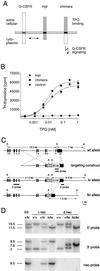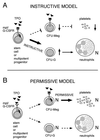Permissive role of thrombopoietin and granulocyte colony-stimulating factor receptors in hematopoietic cell fate decisions in vivo
- PMID: 9892696
- PMCID: PMC15199
- DOI: 10.1073/pnas.96.2.698
Permissive role of thrombopoietin and granulocyte colony-stimulating factor receptors in hematopoietic cell fate decisions in vivo
Abstract
The question of whether extracellular signals influence hematopoiesis by instructing stem cells to commit to a specific hematopoietic lineage (instructive model) or solely by permitting the survival and proliferation of predetermined progenitors (permissive model) has been controversial since the discovery of lineage-dominant hematopoietic cytokines. To study the potential role of cytokines and their receptors in hematopoietic cell fate decisions, we used homologous recombination to replace the thrombopoietin receptor gene (mpl) with a chimeric construct encoding the extracellular domain of mpl and the cytoplasmic domain of the granulocyte colony-stimulating factor receptor (G-CSFR). This chimeric receptor binds thrombopoietin but signals through the G-CSFR intracellular domain. We found that, despite the absence of a functional mpl signaling domain, homozygous knock-in mice had a normal platelet count, indicating that in vivo the cytoplasmic domain of G-CSFR can functionally replace mpl signaling to support normal megakaryopoiesis and platelet formation. This finding is compatible with the permissive model, according to which cytokine receptors provide a nonspecific survival or proliferation signal, and argues against an instructive role of mpl or G-CSFR in hematopoietic cell fate decisions.
Figures




References
Publication types
MeSH terms
Substances
LinkOut - more resources
Full Text Sources
Other Literature Sources
Molecular Biology Databases

